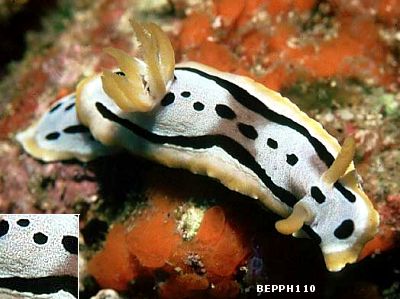
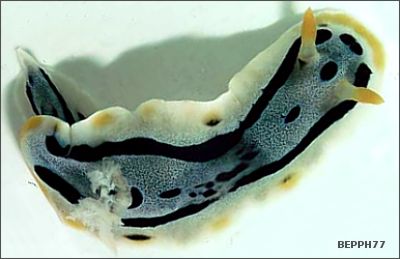
Chromodoris michaeli
Gosliner & Behrens, 1998
Order: NUDIBRANCHIA
Suborder: DORIDINA
Superfamily: EUDORIDOIDEA
Family: Chromodorididae
DISTRIBUTION
Philippine Ids.
PHOTO
BEPPH110 - Apo Island, Negros, Philippines, 1 APR 1983, 5cm. BEPPH77 - Dumaguete, Negros, Philippines, 30 MAR 1983. Photos: Bernard Picton.
Background colour of the mantle appear light blue from a fine dusting of white over a translucent bluish-brown ground colour. There is a fine white line at the mantle margin and a broad orange band just in from the edge, which is described as 'uninterrupted' by Gosliner & Behrens but may be broken (see message below). There is a broad black band encircling the mantle just outside the gills andf the rhinophores. This can be broken anteriorly and posteriorly. There are also a few scattered black spots in the midline. In the original description the gills and rhinophores are described as translucent orange. The foot is bluish with an orange border and two or three black lines. The two photos here, and further photos in Bernard Picton's message below suggest this species is more variable in colour than initially thought. If all the photos are the same species then the orange border can be entire or broken and the gills can be translucent orange, can have an orange band up the outside edge, can be translucent white with no orange, or can be orange in the upper half.
It is similar in colour to C. dianae and other species of the C. quadricolor colour group. Like C. annae and C. westraliensis the blue region of the mantle has the punctate pattern which Gosliner & Behrens describe as 'a fine speckling of white'.
Reference:
• Gosliner, T.M. & Behrens, D.W. (1998) Five new species of Chromodoris (Mollusca: Nudibranchia: Chromodorididae) from the tropical Indo-West Pacific. Proceedings of the California Academy of Sciences, 50: 139-165.
Rudman, W.B., 2001 (June 21) Chromodoris michaeli Gosliner & Behrens, 1998. [In] Sea Slug Forum. Australian Museum, Sydney. Available from http://www.seaslugforum.net/find/chromich
Related messages
Chromodoris michaeli from Ningaloo Reef, W Australia
February 6, 2008
From: Kristin J Anderson

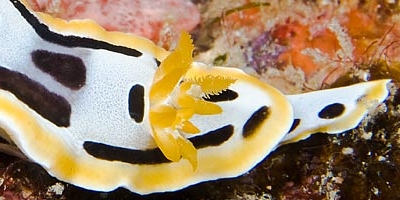
I came across this nudibranch yesterday. It has a pattern I have not seen here before and after browsing the forum, I think it may be Chromodoris michaeli.
It looks like it was seen up north at Ashmore, but there is no listing for this far south as yet.
Locality: Ningaloo Reef, Exmouth, 13m, Western Australia, Indian Ocean, Lighthouse Bay, 21 January 2008, limestone coral reef. Length: 4cms. Photographer: Kristin Anderson.
Kristin Anderson
kristin@oceansbyanderson.com
Anderson, K.J., 2008 (Feb 6) Chromodoris michaeli from Ningaloo Reef, W Australia. [Message in] Sea Slug Forum. Australian Museum, Sydney. Available from http://www.seaslugforum.net/find/21344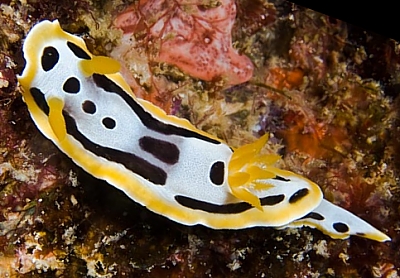
Dear Kristin,
Richard Willan's record from Ashmore Reef [#4808] would seem to be the closest. As I discuss there we still need to better understand the relationship between C. michaeli and the other two very similarly coloured species - C. westraliensis, C. annae - which also have a punctate pattern of dark specks on the blue background colour
Best wishes,
Bill Rudman
Chromodoris michaeli from Sulawesi
May 15, 2003
From: David Thompson
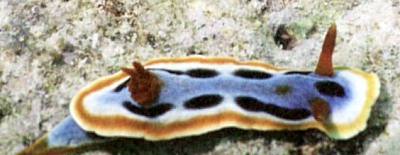
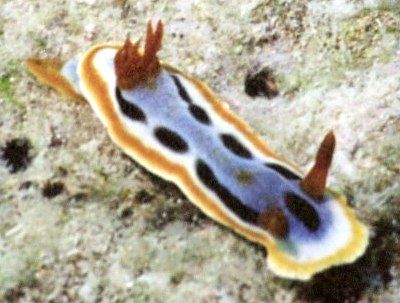
Hi Dr Rudman,
I've attached the photos of a variation of a Chromodoris found in the Wakatobi National Park, SE Sulawesi, Indonesia. It does not seem to be C. magnifica nor does it seem to be C. annae.
David Thompson
diverdavid@ntlworld.com
Thompson, D., 2003 (May 15) Chromodoris michaeli from Sulawesi. [Message in] Sea Slug Forum. Australian Museum, Sydney. Available from http://www.seaslugforum.net/find/9801Dear David,
I'm pretty sure this is C. michaeli. Although the black lines are broken, the punctate pattern in the blue region and the submarginal orange line seem to fit.
Best wishes
Bill Rudman
Re: Chromodoris michaeli? from the Philippines
December 5, 2002
From: Dave Behrens
Bill:
George's photo, submitted by Erwin, looks almost identical to the Holotype. It clearly shows the broken black band at the anterior end and the spots anterior to the gills. The white mantle edge is also a good indicator.
Dave Behrens
dave@seachallengers.com
Thanks Dave,
Bill Rudman
Chromodoris michaeli? from the Philippines
December 4, 2002
From: Erwin Köhler
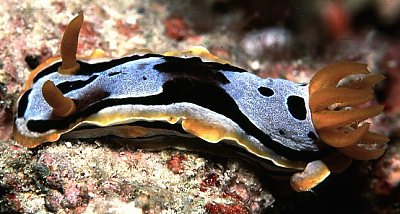

Dear Bill,
Here is one more picture of Georg Heinze [Georg.Heinze@t-online.de] from the Philippines, Cabilao Island, Divesite "Lighthouse"
Is it a colour variant of Chromodoris michaeli?
Size 25mm
Depth 15m
Date May 2002
Erwin
erwin@medslugs.de
Köhler, E., 2002 (Dec 4) Chromodoris michaeli? from the Philippines. [Message in] Sea Slug Forum. Australian Museum, Sydney. Available from http://www.seaslugforum.net/find/8535Dear Erwin,
It certainly looks as though it is. This colour form is definitely starting to look like Chromodoris westraliensis, but in that species the orange border extends right to the edge of the mantle.
Cheers,
Bill Rudman
Chromodoris from Ashmore Reef
July 13, 2001
From: Richard Willan
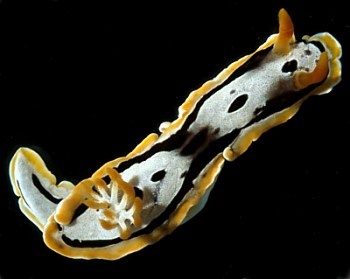
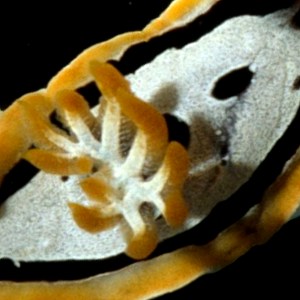
Dear Bill,
I am currently preparing a scientific article on the marine molluscs of the emergent reefs of the Sahul Shelf between northern Western Australia and Timor in Indonesia. One of the chromodorids I collected at Ashmore Reef, one of three
emergent reefs on that shelf, is giving me a lot of trouble coming up with a name to use in my article. I was confident to call it C. westraliensis in 1996 when I collected it because it had the punctate pattern of white specks on the mantle and mid-dorsal transverse dark "saddle" that are typical of C. westraliensis. Knowing that C. westraliensis is highly variable in coloration and that it extends all along the Westwern Australia coast right up to the Kimberley, I did not regard its occurrence on Ashmore as highly unusual.
However the subsequent naming of two new species in the group of Chromodoris species with punctate mantles the 'Chromodoris annae species group' as I would call them) has really puzzled me for a name because it seems this one could be C. michaeli as easily as it could be C. westraliensis. I don't see any immediate answer from the postings by yourself, Bernard Picton, and others on the Forum, though I do see a lot of colour variants of this species complex turning up from the Philippines. My animal from Ashmore (which was old or had escaped from a predator because of its extensively lacerated mantle margin) has a very narrow white marginal band, followed by a broad uninterrupted gold band, followed by a narrow interrupted black band encircling the pale blue punctate central region. The central region has a longitudinal row of black spots with the largest in the centre of the transverse "saddle". The rhinophores and gills are golden.
Thanks for your thoughts on this animal.
Richard
richard.willan@nt.gov.au
Willan, R.C., 2001 (Jul 13) Chromodoris from Ashmore Reef. [Message in] Sea Slug Forum. Australian Museum, Sydney. Available from http://www.seaslugforum.net/find/4808Dear Richard,
Your photo is almost identical to the photo of C. michaeli in the original description. I have posted an enlarged view of the gill region to show the punctate colouration of the mantle. One difference in your animal is the heavy white pigmentation along the inner (upper) edge of the gills.
To your general question about this C. annae colour group. I can only agree that there is something going on here which we certainly need to investigate further. I have long wondered whether C. westraliensis is a regional form of C. annae, the main difference being that C. annae has a white band between the orange border and the inner black bands and C. westralienis does not. However as I show on C. westraliensis page, even that distinction does not seem to hold. As I have discussed in recent messages I think we still need to clarify whether C. dianae is one or more species, where C. michaeli fits in, and as you say there relationship to C. westraliensis and C. annae. I have not found any obvious anatomical differences between any of these 'species', which I guess is not surprising if they are closely related. All I can suggest is that we need to build up more information on the sponges they feed on, their egg masses, development types etc. This is obviously not an overnight answer, but it can give some pretty convincing clues.
This does not answer your immediate question. I think I would call it C. michaeli and add a commentary somewhere noting the possible relationship between this group of species. If they are colour forms of one species it is clearly not a simple geographic cline because Clay Bryce has sent a photo of a pair of 'classic' C. westraliensis from the Kimberley region of north Western Australia.
Best wishes,
Bill Rudman
Re: Colour variation in Chromodoris michaeli
July 5, 2001
From: Erwin Köhler
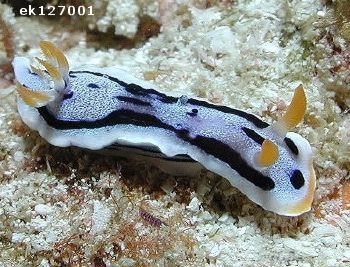
Dear Bill,
here are 3 more of the Chromodoris michaeli lookalikes, all of them from the Philippines, Cebu Island, Moalboal:
ek126702, divesite "Pescador", depth 38 m, length 26 mm, May 30, 2001,
ek126703, divesite "Pescador", depth 33 m, length 29 mm, May 30, 2001,
ek127001, divesite "Tuble", depth 40 m, length 35 mm, May 31, 2001.
Erwin
Erwin@medslugs.de
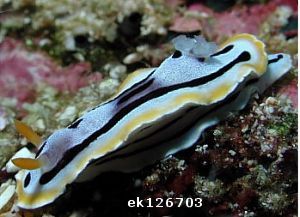
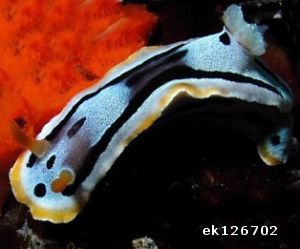
Thanks Erwin,
The more variations we have to consider, the better - I guess.
Bill Rudman
Chromodoris michaeli from Okinawa
June 24, 2001
From: Bob Bolland


OKINAWA, 23 June 2001 / 5:07 am
Hi Bill,
If the California folks haven't already sent you images of Chromodoris michaeli, here are two from Okinawa.
Data:
RFB#3070 / TL: 33mm / 46m (150ft) / Horseshoe Cliffs, Okinawa / 4 Oct '92
RFB#3525-A / TL: 40mm / 55m (180ft) / Seragaki, Okinawa / 8 Nov '96
Cheers,
Bob
bollandr@rapid-link.ne.jp
Bolland, R.F., 2001 (Jun 24) Chromodoris michaeli from Okinawa. [Message in] Sea Slug Forum. Australian Museum, Sydney. Available from http://www.seaslugforum.net/find/4660Thanks Bob,
The more photos the merrier. perhaps we can get all the colour variants to intergrade. In fact the gills in your animals suggest a link between those with an orange band up the outer edge and those with the upper half of the gills orange.
Best wishes,
Bill Rudman
Colour variation in Chromodoris michaeli
June 24, 2001
From: Bernard Picton

Hi Bill,
Here are scans of animals which I collected in 1983 in the Philippines. They seem to be Chromodoris michaeli Gosliner & Behrens, 1998.
These animals show that the submarginal orange band described by Gosliner & Behrens is not always continuous, but can be a series of spots or patches along the sides of the body and continuous at the front and back of the mantle. It is interesting to see that this species, in common with C. annae, C. westraliensis and C. strigata shows a 'saddle' of darker pigment in the middle of the back - is this due to relationship (DNA) or selection mimicry/signalling)?
BEPPH110 - Apo Island, Negros - 1 APR 1983, 5cm.
BEPPH77 - Dumaguete, Negros - 30 MAR 1983
BEPPH76 - Dumaguete, Negros - 30 MAR 1983
BEPPH63 - Mactan Is., Cebu - 27 MAR 1983
BEPPH74 - Dumaguete, Negros - 30 MAR 1983 -
Bernard
bernard.picton.um@nics.gov.uk
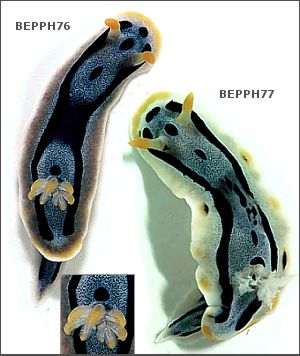
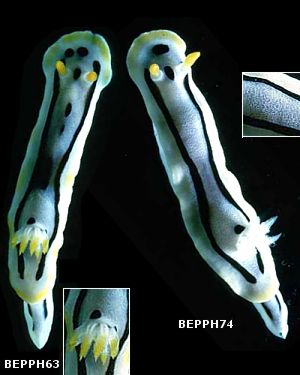
Dear Bernard,
After posting Erwin's message last night I remembered I had put this message of yours to one side until I had time to arrange the wonderful images together. If all these are the same species, then I guess Erwin's earlier photo is also of C. michaeli.
I looked at the anatomy of these specimens when you sent them to me from the Philippines 15 years ago. The reason I did not name them myself is that I could not match the colour patterns with good anatomical differences and so could not decide where to draw the line between species. I still can't. My biggest problem is with the gill colouration. In other groups of similarly coloured species, the detail of the colour pattern on the gills and rhinophores has been consistent and often species specific. In your photos BEPPH110 has translucent orange gills, which I suspect is a variant of gills with just an orange band up the outer edge as in Erwin's photo. BEPPH63 & BEPPH76 appear to have the whole of the upper half of each gill translucent orange, and BEPPH74 & BEPPH77 have colourless gills. If we add to this, the two colour forms found in Chromodoris dianae I still find the situation puzzling.
Thanks for these photos,
Best wishes,
Bill Rudman
Re: Chromodoris michaeli? from the Philippines
June 23, 2001
From: Erwin Köhler
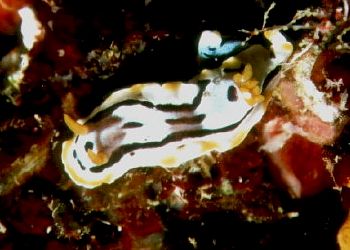
Dear Bill,
Here is a Chromodoris michaeli one from the Philippines, Cebu Island, Moalboal, divesite "housereef", depth 10 m, length about 3 cm, May 2000. This photo was taken by Georg Heinze and identified by David W Behrens. I think it looks like the one I recently sent to you.
Erwin
Erwin@medslugs.de
Köhler, E., 2001 (Jun 23) Re: Chromodoris michaeli? from the Philippines. [Message in] Sea Slug Forum. Australian Museum, Sydney. Available from http://www.seaslugforum.net/find/4648Dear Erwin,
It certainly looks like the animal you sent earlier which I identified as Chromodoris dianae. The one major difference, as I said then, was the colour of the gills. In your earlier photo the gills were translucent colorless, or whitish, with an orange mark on the outer edge, which is characteristic of one of the colour forms of C. dianae. Georg Heinze's photo however shows an animal in which the gills are a uniform translucent orange, which is characteristic of C. michaeli. However in Gosliner & Behren's original description of this species they say that the orange band around the mantle edge is 'uninterrupted'. In this animal the band around the anterior end is 'uninterrupted' but that is certainly not the case around the rest of the mantle edge.
These groups of similarly coloured species of chromodorids are often difficult to separate from one another. If we are correct in thinking that these colour groups are the result of mimicry then it is not surprising that different species look so alike.
Best wishes,
Bill Rudman
